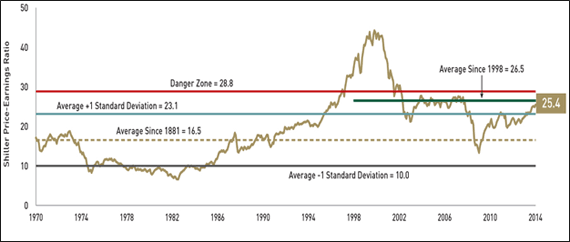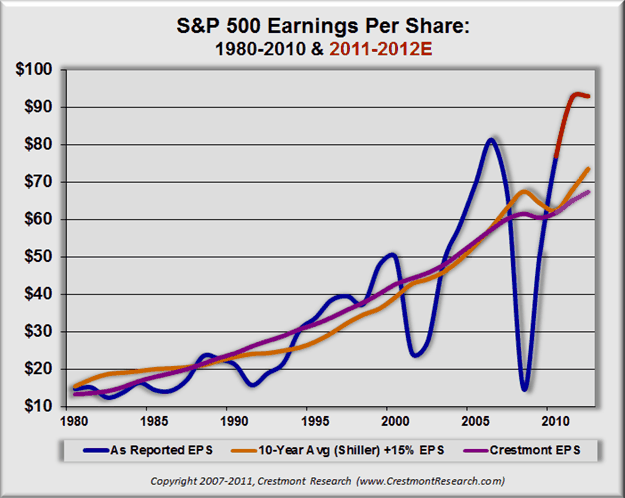The Shiller P
Post on: 15 Июль, 2015 No Comment

A simple valuation metric for the market developed by Professor Robert Shiller, is commonly referred to as the Shiller P/E or P/E 10.
The normal price to earnings ratio is straightforward enough: divide the price of the stock by the EPS to calculate the earnings multiple. For example, a stock priced at $80 with $5 in EPS would have a P/E of 16. It can be used on the whole S&P 500 to come up with the average market valuation as well.
This has some shortcomings, though.
Earnings can be volatile. For a single company, a temporary earnings cut could make the stock look wildly overvalued even if its not. For example, AT&T currently has a P/E of around 50, but this is entirely due to their attempted T-Mobile acquisition which resulted in billions of dollars in losses, and therefore a temporary profit hit that is unrelated to normal operations. I dont view AT&T as a particularly good value at the moment, but its certainly not legitimately at a P/E of 50.
A similar effect can happen to the whole market. During business cycles, earnings can expand and contract. The current earnings at any given time might not be a good representation of what the business performance really is.
Robert Shiller, an economics professor at Yale, provided what is commonly called the Shiller P/E or P/E 10, which is a smoothed out version of the P/E ratio.
To a calculate it, you divide the current price by the inflation-adjusted average of the last ten years of earnings. When this is applied to the S&P 500, it gives a somewhat longer-term view of what the current approximate market valuation is, because it shows a version of the P/E that is smoothed out over a number of years. The earnings part of the P/E equation is smoothed out and less erratic, while the price can still change substantially. So the valuation from this equation is both up-to-date, and yet representative of steadier data.
Robert Shiller is well known for pointing out that stocks were in a bubble prior to the dotcom crash based on this fairly simple formula, and also pointed out housing valuations ahead of the housing bubble by applying similar concepts to real estate.
More specifically, in his book, he pointed out that the P/E at any given time is a fairly good predictor of what the market returns will be over the next two decades. The higher the valuation at any given time, the lower the expected returns are:
Some people may say that you cant predict what the stock market will do. For the most part I agree, but most of this is just common sense- if the Shiller P/E is high, then that means that stock valuation methods like standard Discounted Cash Flow Analysis or the Dividend Discount Model (DDM ), are going to show that stocks are overvalued in general unless spectacular growth is assumed. Combining objective valuation methods with a chart that shows 100 years of cause and effect makes a pretty good case.
I never sat down and read his book, but heres a (referral) link if youre interested:

More specifically, what I do check from time to time, is his up-to-date online data about ongoing market valuations. I commonly mention what the current valuation is in my newsletter.
The Downsides of the Shiller P/E
The power and simplicity of this ratio is quite useful, in my opinion. The long-term results are clear, and its based on common sense.
Its not an absolutely flawless measurement, however. Since its one number, it of course has limitations.
For one, it focuses on net earnings rather than, say, operating earnings or free cash flow. Secondly, a more interesting point is that it doesnt differentiate between newer and older stocks. For example, just because the P/E of the market is high, that doesnt necessarily mean its overvalued, because you could have companies like Amazon with legitimately huge growth pulling up the average valuation, while stocks like Chubb Corporation are marching along at continually low valuations.
So, what you can do with the Shiller P/E is less clear. If you were a pure index investor, you could potentially base your asset allocation decisions regard stocks and bonds partially on the Shiller P/E. As an individual investor, using regular valuation approaches like discounted cash flow or the dividend discount model are a bit more bulletproof, but the Shiller P/E can nonetheless give you a reference point for what the market as a whole looks like for asset allocation decisions.
Sign up for the free dividend and income investing newsletter to get market updates, attractively priced stock ideas, resources, investing tips, commentary on current market valuations via the Shiller P/E, and exclusive investing strategies:














